
COMPUTATIONAL STATISTICS
Scope & Guideline
Bridging computation and statistics for groundbreaking insights.
Introduction
Aims and Scopes
- Statistical Modeling and Inference:
The journal focuses on the development and application of statistical models for inference, including generalized linear models, Bayesian methods, and mixed models, particularly in complex data scenarios. - Computational Techniques and Algorithms:
A key area of interest includes the design and implementation of computational algorithms for statistical inference, such as MCMC methods, variational inference, and optimization techniques for high-dimensional data. - Data Visualization and Interpretation:
The journal emphasizes the importance of effective data visualization techniques, providing insights into statistical results through graphical representations and interactive tools. - Statistical Learning and Machine Learning:
With the rise of big data, the journal includes research on statistical learning methods, machine learning algorithms, and their applications in various fields such as finance, healthcare, and social sciences. - Applications in Diverse Fields:
COMPUTATIONAL STATISTICS publishes studies that apply statistical methods to real-world problems across disciplines, including environmental science, sports analytics, and genomics. - Methodological Innovations:
The journal encourages submissions that propose new statistical methodologies or enhance existing methods to address contemporary challenges in data analysis.
Trending and Emerging
- Bayesian Methods and Hierarchical Models:
There is a significant trend towards the use of Bayesian approaches, particularly hierarchical models, which allow for flexible modeling of complex data structures and incorporation of prior information. - High-Dimensional Data Analysis:
As datasets continue to grow in complexity and size, there is an increasing focus on methodologies tailored for high-dimensional data analysis, including variable selection and regularization techniques. - Machine Learning Integration:
The integration of machine learning techniques with statistical methods is on the rise, emphasizing predictive modeling and feature selection in various applications. - Spatial and Temporal Modeling:
Emerging themes include advanced methods for spatial and temporal data analysis, recognizing the importance of location and time in statistical modeling. - Robust and Adaptive Methods:
There is a growing interest in developing robust statistical methods that can handle outliers and adapt to changing data distributions, ensuring reliable inference under varying conditions. - Data Science and Statistical Computing:
The intersection of data science and statistical computing is becoming increasingly prominent, with a focus on computational tools and frameworks that facilitate data analysis.
Declining or Waning
- Traditional Frequentist Methods:
There has been a noticeable decline in the number of papers focusing solely on traditional frequentist statistical methods, as researchers increasingly adopt Bayesian frameworks and machine learning techniques. - Basic Descriptive Statistics:
Studies centered on basic descriptive statistics are becoming less frequent, overshadowed by more complex analyses that tackle high-dimensional and multivariate data. - Simple Linear Regression Models:
The prevalence of simple linear regression analyses appears to be waning, as the field moves towards more sophisticated modeling approaches that can handle non-linear relationships and interactions. - Classical Time Series Analysis:
Papers emphasizing classical time series methods are less common, with a shift towards advanced techniques such as state-space models and machine learning approaches for temporal data. - Basic Hypothesis Testing:
The focus on basic hypothesis testing procedures is diminishing, as researchers explore more nuanced methods that account for complexity and uncertainty in data.
Similar Journals
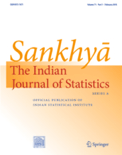
Sankhya-Series A-Mathematical Statistics and Probability
Fostering Interdisciplinary Dialogue in Statistics and MathematicsSankhya-Series A-Mathematical Statistics and Probability is a prestigious academic journal published by SPRINGER, situated in the United States. With a focus on the rapidly evolving fields of mathematical statistics and probability, this journal serves as a critical platform for researchers, professionals, and students seeking to disseminate their findings and engage with latest advancements. Although it is not an open access publication, its rigorous peer-review process ensures high-quality content that contributes to the scholarly community. As of 2023, the journal is classified within the Q3 quartile in both Statistics and Probability, and Statistics, Probability and Uncertainty categories, reflecting its relevance and growing influence in the field. Sankhya-Series A showcases a convergence of interdisciplinary approaches, facilitating dialogue among statisticians and mathematicians, making it an essential resource for those committed to the exploration of theoretical and applied statistics. The journal accepts contributions advancing innovative research and methodologies, promoting a deeper understanding of probabilistic models and statistical techniques.

Computational and Mathematical Methods
Fostering Collaboration for Groundbreaking Computational ResearchComputational and Mathematical Methods is a dynamic peer-reviewed journal published by Wiley-Hindawi, focusing on innovative research in the fields of computational mathematics, mechanics, and theory. Since its transition to an Open Access format in 2022, the journal has enhanced its accessibility to researchers and practitioners globally, providing a platform for the dissemination of high-quality studies that contribute to emerging developments in mathematical modeling and computational techniques. Based in the United Kingdom, this journal is committed to fostering collaboration amongst scholars, evidenced by its rankings within Scopus: Q3 in computational mathematics, computational mechanics, and computational theory and mathematics, reflecting its relevance and influence within these critical fields. With an emphasis on interdisciplinary studies, Computational and Mathematical Methods is an essential resource for researchers, professionals, and students seeking to expand their knowledge and apply cutting-edge methodologies to practical challenges.
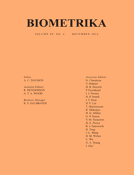
BIOMETRIKA
Advancing the Frontiers of Statistical ScienceBIOMETRIKA, published by the esteemed Oxford University Press, stands as a pivotal journal in the fields of statistics, probability, and applied mathematics since its inception in 1908. With ISSN number 0006-3444 and E-ISSN 1464-3510, this journal maintains an impressive reputation, consistently achieving Q1 rankings across multiple categories including Agricultural and Biological Sciences, Applied Mathematics, and Statistics. Addressed to a global audience from its base in Oxford, United Kingdom, BIOMETRIKA serves as an essential platform for disseminating rigorous research aimed at advancing statistical methodologies and their applications. While the journal does not offer Open Access options, it is recognized for its high-impact output, holding significant positions in Scopus rankings - specifically attaining a 94th percentile rank in General Mathematics and a 91st percentile in Statistics and Probability. Scholars, professionals, and students alike will find in BIOMETRIKA a wealth of knowledge that bridges theory and practice within the vast domain of statistical science, making it indispensable for ongoing research and education in the field.

METRIKA
Innovating Statistical Discourse Since 1958.METRIKA is a distinguished journal published by Springer Heidelberg, specializing in the field of Statistics and Probability. Since its inception in 1958, this journal has been pivotal in advancing the study and application of statistical methods, theory, and research. With an impressive academic legacy extending to 2024, METRIKA holds a Q2 category ranking in both Statistics and Probability and Statistics, Probability and Uncertainty, as of 2023, which underscores its significance within the scholarly community. Researchers and professionals will find that METRIKA not only emphasizes the recent developments and applications in the field but also aims to foster an interdisciplinary dialogue among statisticians and data scientists. Its contributions are invaluable for those seeking to navigate the complexities of statistical methodologies. Although the journal primarily operates under a traditional access model, its commitment to excellence and relevance in statistical discourse ensures that it remains an essential resource for academics, practitioners, and students alike.
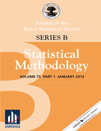
JOURNAL OF THE ROYAL STATISTICAL SOCIETY SERIES B-STATISTICAL METHODOLOGY
Bridging Theory and Practice in StatisticsJOURNAL OF THE ROYAL STATISTICAL SOCIETY SERIES B-STATISTICAL METHODOLOGY, published by OXFORD UNIVERSITY PRESS, is a leading academic journal dedicated to advancing the field of statistical methodology. With a distinguished Q1 ranking in both Statistics and Probability and Statistics, Probability and Uncertainty as of 2023, this journal stands at the forefront of statistical research, serving as a vital resource for researchers, professionals, and students alike. The journal has been committed to fostering innovative statistical techniques and methodologies since its inception in 1997, covering a wide scope of topics that push the boundaries of statistical applications in various disciplines. Based in the United Kingdom, the journal maintains its reputation through rigorous peer-review practices and high-quality content, making it an indispensable platform for those looking to disseminate their findings and engage with current trends in statistical science. Although the journal does not offer open access, the impact and scholarly significance of its articles remain profoundly influential in shaping contemporary statistical discourse.
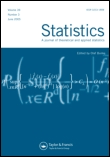
STATISTICS
Empowering researchers to shape the future of statistics.STATISTICS is a distinguished journal published by Taylor & Francis Ltd, dedicated to advancing the field of statistical science since its inception in 1985. With a strong focus on both the theoretical and practical aspects of Statistics and Probability, this journal serves as a vital platform for researchers, professionals, and students seeking to disseminate their findings and contribute to critical discussions in the discipline. Although categorized in the Q3 quartile for both Statistics and Probability and Statistics, Probability and Uncertainty, the journal's commitment to quality research is evidenced by its inclusion in relevant Scopus rankings. It holds respectable positions, ranked #132/168 in Decision Sciences and #219/278 in Mathematics. By providing a venue for high-quality research articles and reviews, STATISTICS aims to foster innovation, reinforce methodological advancements, and address contemporary challenges in statistical applications. The journal does not currently offer open access, but it is widely distributed, ensuring that significant research reaches the communities that need it most. Researchers are encouraged to submit their work to this essential resource that continues to shape the landscape of statistical inquiry.
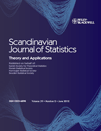
SCANDINAVIAN JOURNAL OF STATISTICS
Pioneering insights in the realm of statistical sciences.SCANDINAVIAN JOURNAL OF STATISTICS is a premier publication in the field of statistics, published by Wiley. With an impressive impact factor that reflects its influence, this journal is recognized for its rigorous peer-reviewed research articles that contribute to the advancement of statistical methods and their applications. As a leading resource, the journal spans a wide range of topics within Statistics and Probability, maintaining a strong scholarly presence with a Q1 rank in Statistics and Probability and a Q2 rank in Statistics, Probability and Uncertainty as per the 2023 category quartiles. The journal has been diligently publishing high-quality research since 1996, and now encompasses studies up to 2024, reinforcing its commitment to providing valuable insights for researchers, professionals, and students alike. While the journal does not offer open access, it remains an essential repository of knowledge in statistical sciences, fostering collaboration and innovation within the global academic community.

STATISTICA SINICA
Pioneering Insights for Data-Driven DecisionsSTATISTICA SINICA, published by the esteemed STATISTICA SINICA organization, stands as a premier journal in the fields of Statistics and Probability, boasting a significant impact within the academic community. With an ISSN of 1017-0405 and E-ISSN of 1996-8507, this journal has evolved from its inception in 1996, continuing to publish cutting-edge research through 2024. As recognized by its recent categorization in Q1 quartiles in both Statistics and Probability and Statistics, Probability and Uncertainty for 2023, it ranks among the top journals in its discipline, meriting attention from researchers and practitioners alike. Despite lacking open access options, it delivers rigorous, peer-reviewed articles that contribute to the advancement of statistical science. With its base in Taiwan, and a dedicated editorial team located at the Institute of Statistical Science, Academia Sinica, Taipei, STATISTICA SINICA continues to be a vital resource for statisticians, data scientists, and related professionals seeking innovative methodologies and insights within this dynamic field.
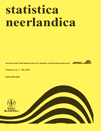
STATISTICA NEERLANDICA
Innovating methodologies for a deeper understanding of statistics.STATISTICA NEERLANDICA is a prestigious peer-reviewed journal published by Wiley, focusing on the fields of statistics and probability. Established in 1946 and addressing key issues in statistical theory and its applications, the journal has significantly contributed to the development of modern statistical practices. With an impressive Q2 categorization in both Statistics and Probability, as well as Statistics, Probability, and Uncertainty, STATISTICA NEERLANDICA stands out within its field, ranking in the 62nd percentile among its peers in mathematics, specifically in statistics and probability. Researchers, professionals, and students can benefit from its rigorous scholarship and innovative methodologies, aiding in the advancement of statistical science. Although the journal does not operate under an open access model, it maintains a commitment to disseminating high-quality research, making it a vital resource for those engaged in statistical inquiry.

Foundations of Data Science
Unlocking the Potential of Data through CollaborationFoundations of Data Science, published by the American Institute of Mathematical Sciences (AIMS), is a pioneering journal dedicated to advancing knowledge within the ever-evolving fields of data science, mathematics, and computational theory. With an impact factor reflecting its quality and relevance, this journal has established itself as a crucial resource for researchers and professionals alike, achieving remarkable rankings in the Scopus metrics across various mathematical categories, including 35th in Analysis and 70th in Statistics and Probability. The journal, which has been continuously growing in significance since its inception in 2019, focuses on both foundational theories and applied methodologies, providing open access to cutting-edge research from 2024 onward. Its commitment to fostering interdisciplinary collaboration ensures that it remains at the forefront of the data science realm, making it an essential platform for students, scholars, and practitioners aiming to deepen their understanding and contribute to the scientific community.